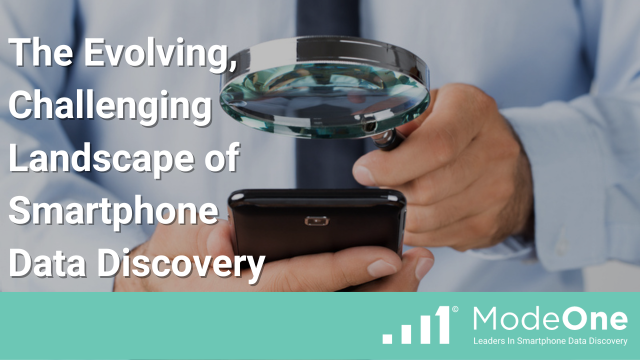Since the pandemic, there have been drastic changes in the reach and scope of investigations and electronic discovery, making it challenging to conduct traditional e-discovery and preserve, collect, and review data stored on Apple and Android smartphones. Legal professionals and e-discovery providers must adapt to these changes and adjust their collection practices accordingly to respond promptly and efficiently to e-discovery requests while preserving the privacy of smartphone owners.
The Changing Landscape
Since before the global pandemic, electronically stored information (ESI) has grown exponentially, appearing unstoppable and unsustainable, as each day people generate 500 million X (formerly known as Twitter) posts, 294 billion emails, 4 million gigabytes of Facebook data, 65 billion WhatsApp messages, and 720,000 hours of new content added daily on YouTube. In 2018, the total data available to e-discovery worldwide was 33 zettabytes (ZB). For 2020, the number grew to 59 ZB, and may expand to 175 ZB by 2025! There’s no telling how high these numbers will be when we add AI-generated content.
COVID-19 forced many to shelter at home and conduct work and play online. Remote work using team workspaces, social platforms, electronic whiteboards, video conferencing, and instant messaging replaced the physical workplace. Remote workers use many of these tools on their smartphones to collaborate outside the office and communicate with colleagues, customers, suppliers, and other business associates. And that makes their smartphones e-discovery targets when litigation and investigations ensue.
In the post-pandemic world, remote work has become the norm for millions of employees. More people seek job opportunities with flexible schedules and remote work options. New generations of workers prioritize a work-life balance and yet, to optimize their performance, combine the creation and storage of data relating to their personal and work lives on their smartphones.
Increasing data volumes, new collaboration tools with complex data formats, and remote work environments change and challenge how e-discovery professionals collect ESI from smartphones and incorporate the data into core e-discovery workflows.
Smartphone Data Collection Challenges
According to Norton Rose Fulbright’s 2023 Annual Litigation Trends Survey, 43 percent of more than 430 litigation leaders surveyed felt very prepared to address litigation in the year ahead, and 40 percent felt somewhat prepared, attributing their confidence to in-house litigation experience, risk management practices, and in-house software and litigation platforms. Respondents did not feel fully prepared due to the cost of outside counsel, inadequate staffing, and a lack of technology and tools. Whether or not professionals feel litigation-ready, remote work creates additional privacy and security risks, increased costs, and logistics concerns to any business.
Employees may use personal devices outside the workplace that do not comply with corporate information, privacy, and security policies. Corporate and personal data can become intertwined on personal devices, and company information can go to unapproved apps and unencrypted storage. When smartphones become e-discovery data targets in litigation, it isn’t easy to know where corporate data is stored, to determine who has access to it, and collect it efficiently for document review. Separating personal information from corporate data to maintain privacy interests and adhere to international and US privacy frameworks is extremely challenging.
Remote workers may use unencrypted file-sharing services that can compromise data confidentiality and integrity. When remote workers come into the office, they will want to bring their devices to work with or without the blessing of a bring-your-own-device (BYOD) policy.
Most organizations introduced policies and procedures to capture and preserve information when anticipating litigation. Yet, smartphone collaboration tools create significant amounts of discoverable data. They also use complex data formats. Collaboration and chat-based platforms, such as Microsoft Teams, Slack, and virtual meeting platforms, like Zoom and Webex, create and store various data types that traditional e-discovery tools can’t collect and process. If e-discovery professionals must collect data remotely, additional expertise and technology is necessary to connect to various smartphones, where remote storage and data synchronization can present obstacles.
With the exponential growth and increasing complexity of ESI data, innovating and leveraging new technology is critical to e-discovery efficacy. For comprehensive document review, eDiscovery providers must overcome challenges in collecting, processing and rendering smartphone data into existing workflows.
Embracing Change and Overcoming Challenges in Smartphone Data Collection
First, businesses should implement an information management policy to reduce data volumes and the amount of data at risk in litigation to lessen their e-discovery spend and decrease their “time-to-facts.” Second, they should use a mobile device management (MDM) solution to limit smartphone usage to approved apps and data storage. Third, businesses should use early case assessment tools for prelitigation preparedness and a remote collection tool that collects only the relevant data needed to respond to discovery requests.
ModeOne’s patented remote, automated smartphone data collection technology is a game-changing software-as-a-service (SaaS) framework that empowers users to collect only the information responsive to litigation, compliance initiatives, or investigations. It helps legal professionals manage case facts and obtain and analyze vital evidence stored on smartphones and short-message chat applications using an automated, defensible, secure, and cost-certain workflow.
Book a demo of ModeOne’s revolutionary solution for remote, same-day collection of targeted smartphone data collection and see how it can help you embrace and overcome the many changes and challenges in eDiscovery.
